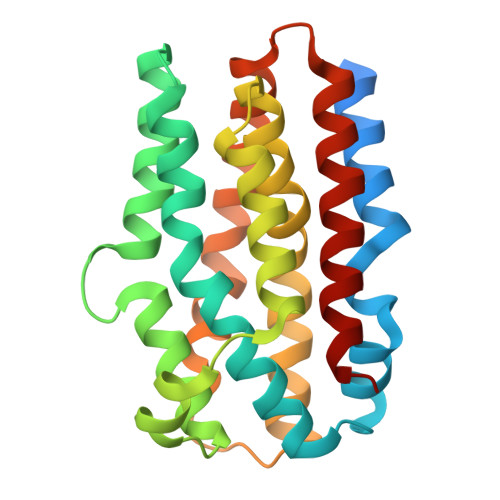Assembly of a Heterobimetallic Fe/Mn Cofactor in the para -Aminobenzoate Synthase Chlamydia Protein Associating with Death Domains (CADD) Initiates Long-Range Radical Hole-Hopping.
Phan, H.N., Swartz, P.D., Gangopadhyay, M., Guo, Y., Smirnov, A.I., Makris, T.M.(2024) Biochemistry 63: 3020-3029
- PubMed: 39471288
- DOI: https://doi.org/10.1021/acs.biochem.4c00326
- Primary Citation of Related Structures:
8VA9, 8VAB, 8VAG, 8VAI - PubMed Abstract:
Chlamydia protein associating with death domains ( Ct CADD) is involved in the biosynthesis of p -aminobenzoic acid (pABA) for integration into folate, a critical cofactor that is required for pathogenic survival. CADD activates dioxygen and utilizes its own tyrosine and lysine as synthons to furnish the carboxylate, carbon backbone, and amine group of pABA in a complex multistep mechanism. Unlike other members of the heme oxygenase-like dimetal oxidase (HDO) superfamily that typically house an Fe 2 cofactor, previous activity studies have shown that Ct CADD likely uses a heterobimetallic Fe/Mn center. The structure of the Fe 2+ /Mn 2+ cofactor and how the conserved HDO scaffold mediates metal selectivity have remained enigmatic. Adopting an in crystallo metalation approach, Ct CADD was solved in the apo, Fe 2+ 2 , Mn 2+ 2 , and catalytically active Fe 2+ /Mn 2+ forms to identify the probable site for Mn binding. The analysis of Ct CADD active-site variants further reinforces the importance of the secondary coordination sphere on cofactor preference for competent pABA formation. Rapid kinetic optical and electron paramagnetic resonance (EPR) studies show that the heterobimetallic cofactor selectively reacts with dioxygen and likely initiates pABA assembly through the formation of a transient tyrosine radical intermediate and a resultant heterobimetallic Mn 3+ /Fe 3+ cluster.
Organizational Affiliation:
Department of Molecular and Structural Biochemistry, North Carolina State University, Raleigh, North Carolina 27695, United States.















